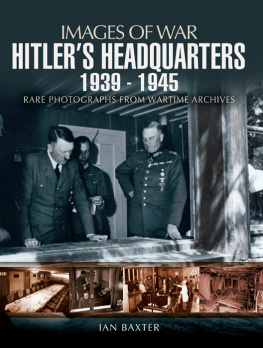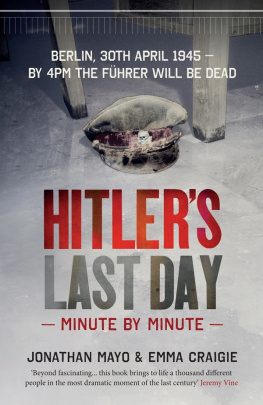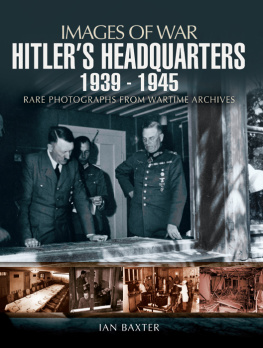Pagebreaks of the print version

Escaping Hitlers Bunker
Escaping Hitlers Bunker
The Fate of the Third Reichs Leaders
Sjoerd J. de Boer
First published in Great Britain in 2021 by
Frontline Books
An imprint of
Pen & Sword Books Ltd
Yorkshire Philadelphia
Copyright Sjoerd J. de Boer 2021
ISBN 978 1 52679 269 3
ePUB ISBN 978 1 52679 270 9
Mobi ISBN 978 1 52679 271 6
The right of Sjoerd J. de Boer to be identified as Author of this work has been asserted by him in accordance with the Copyright, Designs and Patents Act 1988.
A CIP catalogue record for this book is available from the British Library.
All rights reserved. No part of this book may be reproduced or transmitted in any form or by any means, electronic or mechanical including photocopying, recording or by any information storage and retrieval system, without permission from the Publisher in writing.
Pen & Sword Books Limited incorporates the imprints of Atlas, Archaeology, Aviation, Discovery, Family History, Fiction, History, Maritime, Military, Military Classics, Politics, Select, Transport, True Crime, Air World, Frontline Publishing, Leo Cooper, Remember When, Seaforth Publishing, The Praetorian Press, Wharncliffe Local History, Wharncliffe Transport, Wharncliffe True Crime and White Owl.
For a complete list of Pen & Sword titles please contact
PEN & SWORD BOOKS LIMITED
47 Church Street, Barnsley, South Yorkshire, S70 2AS, England
E-mail:
Website: www.pen-and-sword.co.uk
Or
PEN AND SWORD BOOKS
1950 Lawrence Rd, Havertown, PA 19083, USA
E-mail:
Website: www.penandswordbooks.com
Introduction
T hrough underground tunnels, crawling over barbed wire, swimming and rowing across rivers, by car, plane, on the back of a truck full of paintings or by foot. Many of Hitlers most noteworthy followers, who were still in the vicinity of the Fhrerbunker in Berlin at the end of the war, tried to escape the city in all sorts of ways.
This was quite difficult to achieve. The city was almost completely surrounded by the Soviet army, so getting away was a life-threatening operation and, just before Hitlers death, almost impossible. There had been better opportunities in the days right after the Fhrers birthday on 20 April, ten days later, after Hitlers death, there was only one route still open: the route past the Weidendammer Brcke across the River Spree.
Not everyone wanted to flee. Because Hitler was no longer alive and the Third Reich would soon cease to exist, Joseph and Magda Goebbels committed suicide, as did a number of army officers who remained in the grounds of the Reich Chancellery. But the majority of the people that were there did not want to die and tried to escape from a shelter that had become something akin to a prison for them.
Not only the prominent figures, such as ministers, civil servants and members of the armed forces, left Berlin. Secretaries, doctors and unknown boys of the Hitler Youth also wanted to leave the bunker area as quickly as possible.
Several eyewitness reports tell us how they tried to get away, and this book gives an overview of many of those accounts. In words and in pictures, the story of the escape of the most famous inhabitants of the bunker and the Chancellery during the last days of the Third Reich is told here.
The story begins with the last ten days of Hitlers life and then follows the routes of those who fled. Some of the escapees did not see Germany for years because they ended up in a prison in Moscow, while others already in flight crossed paths several times. Many of them went to Flensburg, near the Danish border, where Admiral Dnitz managed to stretch out the Third Reich just a little longer. Others had left for the Obersalzberg or Bayern. Others tried to reach their families as soon as possible. An exciting highlight is the flight of a number of groups from the Chancellerys bunkers, at the very last moment, when men like Martin Bormann, Artur Axmann, Wilhelm Mohnke and Rochus Misch used the final narrow metres of German territory to escape the city.
When it was all over, it was a long time before most of the signs of war disappeared from the city. Although many buildings, bridges and streets were reconstructed or replaced, numerous locations still bear the marks of the violence of war and the Third Reich. Not only in central Berlin, but also the airports, houses, villas, ruins and dilapidated military sites outside the city are reminders of that period. A lot of these locations are featured in this book.
Chapter 1
The Last Days Inside the Bunker
I ts 30 April 1945. Hitler is dead. In his Berlin bunker, where he married Eva Braun the day before, there are not many people left. But in its vicinity there are all kinds of people: soldiers, guards, senior officers, party leaders, generals, secretaries, chamber servants and a large group of boys from the Hitler Youth. Many of them still want to flee the city, preferably to the west, towards the American and British armies. But the city centre, where the bunker is located, is surrounded by the Soviet army and there are only a few ways out of the city left.
Ten days earlier Hitler had turned 56. Telegrams and telephone calls with congratulations flooded in throughout the day and into the evening Propaganda Minister Joseph Goebbels had praised him for his greatness in a radio speech. While the citys airports were still accessible and a number of routes to the centre remained open, he proudly said that the Fhrer would never abandon his people, not even in these difficult times.

The main entrance to the ruined New Reich Chancellery, on Vostrae. This picture was taken in July 1945, by British Lieutenant Frank Barnes of the 2nd Battalion Devonshire Regiment. ( Picture: James Luto Collection )

A view of the Old Reich Chancellery and its modern extension, as seen from Wilhelmplatz, after the end of the war. Both the old and the new part of the Old Chancellery were badly damaged by bombing and the fighting in 1945. ( Picture: NARA )
Several important party members and ministers visited the Fhrer that day. Even Hermann Gring, the man who devoted more time to his art collection and his addiction than on coordinating the air force. Heinrich Himmler, the SS leader responsible for the largest derailments of the empire inside the concentration camps, also paid a visit. Of course, Minister of Armaments Albert Speer, who after the war preferred to speak of his apolitical career as an architect than about his responsibility for the production of arms with which he had prolonged the war enormously, came to congratulate Hitler. In addition, there was Artur Axmann, the youth leader under whose command the young members of the Hitler Youth were sent to their deaths during the last days of the Third Reich. The Minister of Foreign Affairs, Joachim von Ribbentrop, who was scorned by many of his colleagues, also called on the Fhrer as well as the fanatical Joseph Goebbels, who would be the last to abandon his Fhrer. Hitlers private secretary, Martin Bormann, had hardly ever left Hitlers side over the years.















